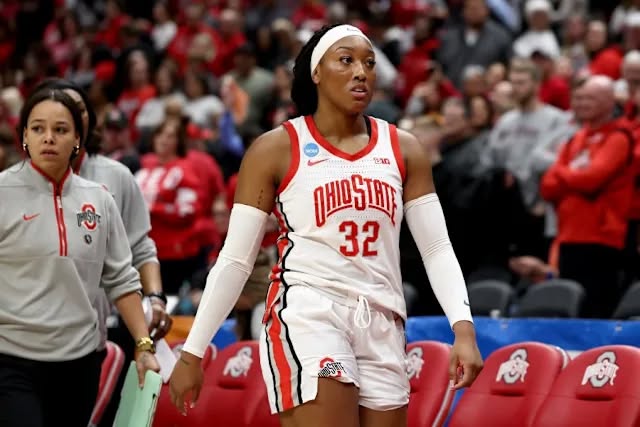The world of collegiate sports is one of constant change, with high-profile transfers often shifting the landscape of entire programs. In the case of Ohio State women’s basketball, the departure of star player Cotie McMahon has raised questions not only about the future of the team but also about the overall stability and future direction of the program. McMahon, known for her versatility and scoring ability, played a pivotal role in Ohio State’s recent success, leading the team through the competitive Big Ten landscape. Her transfer has caused ripples, leaving fans and analysts alike wondering what this means for head coach Kevin McGuff’s squad moving forward.
Simultaneously, in the realm of professional sports, the Columbus Blue Jackets continue to remain relevant in the world of NHL hockey. While the Blue Jackets may not have achieved the same level of success as some of the league’s elite franchises, their persistence in staying competitive in a rapidly evolving NHL landscape speaks volumes about the strength of their organization. The team’s trajectory is something that resonates deeply with the Ohio sports community, which has always had a loyal following for its teams, whether in basketball, hockey, or football.
This article aims to explore the implications of Cotie McMahon’s transfer for Ohio State’s women’s basketball program and also look at how the Columbus Blue Jackets continue to maintain their relevance in the NHL, particularly as Ohio’s professional and collegiate sports teams navigate their respective challenges in a highly competitive environment.
I. Cotie McMahon’s Transfer and Its Impact on Ohio State Women’s Basketball
A. Background of Cotie McMahon
Before discussing the implications of her departure, it’s important to recognize the remarkable impact Cotie McMahon had during her time with Ohio State. A standout player, McMahon was known for her exceptional scoring ability, basketball IQ, and leadership on the floor. A versatile guard/forward, she was instrumental in helping lead Ohio State to several successful seasons within the Big Ten Conference, which is often regarded as one of the most competitive in women’s college basketball. Her skills were on full display as she became one of the team’s most reliable players, consistently contributing both offensively and defensively.
McMahon’s work ethic, along with her ability to adapt and excel in Ohio State’s system, made her a fan favorite and a crucial part of the Buckeyes’ identity on the court. In her time at Ohio State, she helped elevate the program’s profile and establish it as a perennial contender in the NCAA tournament. Her departure has left a significant void, one that’s hard to fill considering her contributions to the team.
B. The Timing and Circumstances of Her Transfer
The timing of McMahon’s transfer came as a surprise to many. While the nature of player transfers in college basketball is not new, McMahon’s decision to leave raised eyebrows, particularly given her prominent role within the program. It’s important to note that transfers in women’s college basketball have become a common occurrence, often driven by a range of factors including playing time, coaching changes, team dynamics, or personal preferences. McMahon’s reasons for transferring are multi-faceted, but her departure nonetheless leaves Ohio State with big shoes to fill.
While McMahon has yet to publicly elaborate on all the reasons for her decision, speculation around her transfer centers on several factors. First, there may have been a desire for new challenges and opportunities elsewhere, as many athletes opt for transfers to pursue different systems, or to play for higher-profile programs. Alternatively, it could be the case that McMahon’s decision was influenced by Ohio State’s recruitment of new talent, team chemistry issues, or personal reasons that she felt required a change of scenery.
C. What Does McMahon’s Transfer Mean for Ohio State’s Future?
Ohio State’s women’s basketball program, under head coach Kevin McGuff, has established itself as a top-tier program in the NCAA. However, McMahon’s departure raises questions about how the team will adapt. Without a player of McMahon’s caliber, Ohio State will likely need to rely more heavily on other returning players to step up and fill the leadership void. McGuff has shown a strong ability to recruit and develop talent, so it’s likely that he will look to incoming recruits or transfers to bolster the roster.
The program may face some immediate challenges as they work to replace McMahon’s production and leadership. The question becomes whether Ohio State’s coaching staff can adapt to a post-McMahon world and continue to compete at a high level within the Big Ten. The loss of a star player like McMahon could impact the team’s cohesion and depth, forcing the Buckeyes to recalibrate their strategies moving forward.
II. The Relevance of the Columbus Blue Jackets in the NHL
A. Overview of the Blue Jackets’ History and Status in the NHL
The Columbus Blue Jackets, an NHL expansion team that began play in 2000, has had a rocky but promising history. Despite the challenges of being a relatively new franchise in a league filled with storied teams, the Blue Jackets have built a reputation for being a competitive team in a tough division. While they haven’t been able to achieve consistent success at the level of more established teams, they have made key strides and become a team that fans can rally behind.
One of the key moments in the franchise’s history came in 2019 when the Blue Jackets made a historic playoff run, sweeping the Tampa Bay Lightning in the first round, one of the biggest upsets in recent NHL history. This victory helped establish the team as a legitimate playoff contender and gave Columbus a newfound sense of pride and excitement. While they have struggled to maintain that level of success in subsequent seasons, their perseverance and ability to stay relevant in a competitive NHL landscape has been commendable.
B. Factors Contributing to the Blue Jackets’ Continued Relevance
The Blue Jackets’ continued relevance in the NHL can be attributed to several factors. First, the team has a loyal and passionate fan base that has supported the team since its inception. The city of Columbus, though relatively small in comparison to other major NHL markets, has embraced its team with an energy and enthusiasm that has propelled the Blue Jackets forward. The Nationwide Arena, the home of the Blue Jackets, has become a center of activity during the NHL season, drawing in fans from all over the region.
Second, the Blue Jackets have been active in developing young talent. Their farm system has produced some notable players, including stars like Johnny Gaudreau and Patrik Laine. By focusing on building a competitive roster through both the draft and strategic trades, the Blue Jackets have managed to remain relevant in the NHL’s Eastern Conference. While they may not be perennial Cup contenders, the team’s consistency in staying competitive is a credit to its management and scouting departments.
C. The Blue Jackets’ Role in Ohio’s Sports Landscape
In a state known for its rich sports culture, the Blue Jackets have carved out their own niche, despite competition from other major Ohio-based teams such as the Cleveland Browns, Cleveland Cavaliers, and Cincinnati Reds. Ohioans have long been passionate about their sports teams, and the Blue Jackets have earned their place in that conversation. The team’s grit and determination resonate with fans who appreciate underdog stories, making the Blue Jackets a symbol of perseverance and hope for their loyal followers.
Even when the team has faced adversity, the Blue Jackets have managed to maintain a level of relevance in Ohio’s sports culture. This speaks not only to the strength of the franchise but also to the importance of community and fan connection. The Blue Jackets may not have the same historic prestige as some of the NHL’s top teams, but their consistent ability to draw fans and maintain a competitive roster ensures that they remain an integral part of the Ohio sports scene.
III. Parallels Between Ohio State Women’s Basketball and the Blue Jackets
While Ohio State’s women’s basketball program and the Columbus Blue Jackets operate in very different sports environments, there are notable parallels in how both entities navigate challenges and continue to maintain relevance. Both face the challenge of competing in highly competitive environments where success isn’t always guaranteed. Yet, both teams have demonstrated resilience and a commitment to improvement.
The Blue Jackets’ persistence in staying competitive within the NHL despite being a relatively young franchise mirrors Ohio State’s ability to maintain its position as a top-tier women’s basketball program in the Big Ten. Both teams rely on strong leadership, talent development, and fan engagement to sustain their relevance. Whether it’s through McGuff’s ability to recruit and develop players or the Blue Jackets’ emphasis on young talent, the common thread is a commitment to growth and evolution.



